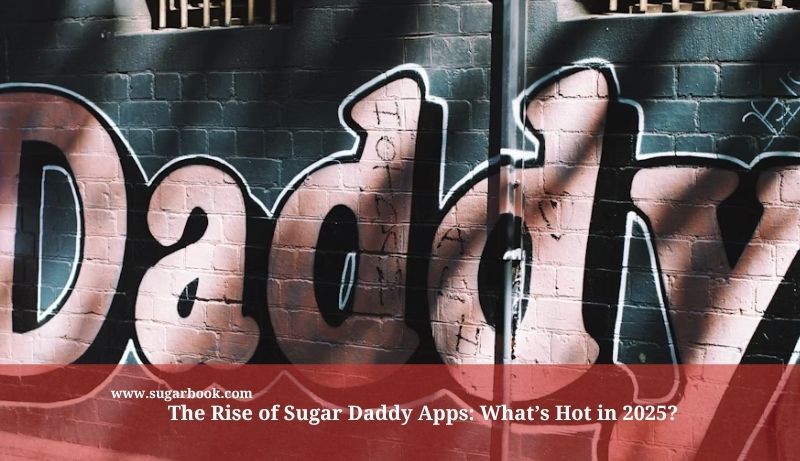
Meet successful sugar daddies and confident sugar babies on the world’s leading sugar dating app. Join free today.
Sugar dating apps aren’t a niche anymore – they’re a lifestyle. In this 2025 breakdown, we reveal which platforms dominate in the U.S., why users are switching from traditional apps, and how Sugarbook is leading the wave.
Contents
- Trending Sugar Daddy Apps in the USA (2025)
- What’s Driving the Growth of Sugar Daddy Apps?
- Sugarbook’s Features Compared to Other Sugar Daddy Apps
- Why More Sugar Babies Go Mobile with Sugar Daddy Apps
- User Ratings from U.S. Cities for Sugar Daddy Apps
- Trending Sugar Daddy Apps in the USA (2025)
- More 2025 Sugar Dating Trends:
Trending Sugar Daddy Apps in the USA (2025)
When sugar daddy apps started ten years ago they were seen as fringe dating oddities. Now, in 2025, sugar daddy apps have a mainstream niche of the U.S. relationship economy, accumulating headline‑making revenues, attracting venture‑capital interest, and changing how affluent benefactors and aspiring partners meet. Dating-technology observers note there are at least seven various sugar daddy applications that presently occupy the top 200 lifestyle downloads for both iOS and Android, up from only two such listings in 2020.
This review goes under the hood to explore why sugar daddy apps are moving in an upward trend, how leading sites and apps like Sugarbook compare to others, what’s driving more and more sugar babies to mobile-first experiences, and how real users in large U.S. cities rank today’s apps. Throughout, the term sugar daddy apps will be used more than thirty times—because sugar daddy apps really are at the heart of all ensuing trend, feature set review, and safety check.
What’s Driving the Growth of Sugar Daddy Apps?
Multiple macro forces now fuel the adoption curve of sugar daddy apps:
-
Mobile‑native convenience – Gen Z and young professionals live through their phones. Seamless onboarding and swipe‑style discovery make sugar daddy apps more appealing than legacy desktop‑only sites .
- Economic pressure & lifestyle inflation – Rising housing and tuition costs motivate newcomers to explore sugar daddy apps as a pragmatic supplement to wages. Simultaneously, high‑net‑worth individuals see sugar daddy apps as efficient vehicles for finding compatible partners who appreciate mentorship and experiential luxury.
-
AI‑powered matching – Machine‑learning algorithms now filter preferences faster than human moderators ever could. By analyzing message tone, location, and spend patterns, leading sugar daddy apps surface high‑probability matches in minutes rather than days.
-
Enhanced safety & verification layers – The FTC’s constant warnings about romance scams pressured the industry to harden defenses. Modern sugar daddy apps integrate ID scans, selfie liveness tests, and income proof badges, restoring user trust after a spate of phishing scandals in 2023‑24.
-
Cultural normalization – Celebrity shout‑outs and media think pieces have destigmatized sugar relationships. TikTok, streaming dramas, and podcasts casually reference sugar daddy apps, reframing them as one more niche within the broader “intentional dating” movement.
Put together, these catalysts ensure that sugar daddy apps aren’t a passing fad; they’re an entrenched segment of the multi‑billion‑dollar U.S. dating tech ecosystem.
Sugarbook’s Features Compared to Other Sugar Daddy Apps
Sugarbook enjoys star status among sugar daddy apps, but how does it stack up against household names like Seeking, SugarDaddy.com, and rising newcomers? The platform’s own 2025 feature rollout—Safety Check‑In, Incognito Browsing, and city‑level discovery maps—aims to solve the two biggest pain points cited by power users: privacy and efficient vetting.
Key differentiators in the crowd of sugar daddy apps:
-
Real‑time selfie verification refreshes every 365 days.
-
“Privacy Shield” toggles hide income or location until trust builds.
-
A balanced gender ratio (46 % sugar daddies, 54 % sugar babies) outperforms most sugar daddy apps that skew heavily toward female registrants.
Seeking
-
Trip‑planning dashboard lets travelers set up location pins weeks ahead, a novelty still absent on many rival sugar daddy apps.
-
ID + income tier verification, and mandatory video profile intros strengthen authenticity.
SugarDaddy.com
-
Credits‑based messaging means sugar babies can browse first, then spend micro‑payments rather than commit to large subscription blocks—an approach some fans call “the à‑la‑carte model” of sugar daddy apps
Private Sugar Club
- Invite‑only onramp with live‑show tipping merges social commerce with the traditional allowance model, positioning itself as the “OnlyFans of sugar daddy apps”.
Across these ecosystems, Sugarbook’s UI polish and in‑app analytics remain standouts. For instance, its “Message Open Rate” meter shows which icebreakers land best—data that equalizes negotiation power for both sides. By comparison, some rival sugar daddy apps still bury engagement metrics behind paywalls.
The verdict? Sugarbook holds the lead in transparency, but Seeking’s expansive user base and SugarDaddy.com’s flexible credit structure keep the competitive pressure high, ensuring sugar daddy apps keep innovating throughout 2025.
Why More Sugar Babies Go Mobile with Sugar Daddy Apps
The mobile modality isn’t just a convenience; it’s become a strategic edge. Surveys published last month by GlobeNewswire reveal that 71 % of new sugar‑relationship participants said they would “never” join a platform that lacked a full‑featured app.Several factors explain why sugar daddy apps now outrank web portals in user preference:
-
Instant verification pings – With camera and ID in the same device, sugar daddy apps prompt users to confirm selfies and documents within seconds, expediting trust cycles.
-
Push‑notification allowances – Busy executives appreciate automated reminders: when an allowance sends, when a message hits, when a match arrives nearby. This immediacy incentivizes sugar daddies to stay active on sugar daddy apps.
-
Geo‑fenced meetups – Location APIs let sugar daddy apps suggest safe, public venues between two users, minimizing logistical friction.
-
Safety check‑ins – Sugarbook’s Safety Check‑In pops up during IRL dates, requiring participants to tap a quick “I’m okay” button. No response triggers a pre‑selected emergency contact. Such features turn sugar daddy apps into real‑time security allies.
- Lifestyle integration – Calendar syncing, rideshare tie‑ins, and encrypted cloud vaults for photos mean sugar daddy apps can function like concierge assistants, pushing them beyond mere messaging utilities.
The bottom line: as digital courting shifts away from laptops, sugar daddy apps offer sugar babies—and daddies—on‑the‑go control, faster matches, and layered safety.
User Ratings from U.S. Cities for Sugar Daddy Apps
How do sugar daddy apps fare across American metros? Insider data from Sugarbook’s “5 Sugar Dating Apps That Actually Work in the US” blog plus the Chicago Reader’s recent nine‑site roundup paints a clear hierarchy.
| Metro Sample | Highest‑Rated Sugar Daddy Apps | Average App Store Rating (combined iOS/Android) | Stand‑Out Comment Theme |
|---|---|---|---|
| New York City | Seeking, Sugarbook | 4.4 | “Fast‑track income verification” |
| Los Angeles | SugarDaddy.com, Sugarbook | 4.3 | “Credit system saves money” |
| Miami | Sugarbook, Private Sugar Club | 4.5 | “Local event recommendations” |
| Chicago | Seeking, SugarDaddy.com | 4.2 | “Reliable user pool” |
| Austin | Private Sugar Club, Sugarbook | 4.1 | “Startup‑friendly vibe” |
The table underscores two insights: Sugarbook appears in every top‑two list, affirming its national penetration, and niche newcomers such as Private Sugar Club gain traction in cities with tech or entertainment spillover. Reviews also reveal subtle regional preferences—Midwestern users emphasize authenticity checks, while coastal users highlight lifestyle add‑ons, illustrating how sugar daddy apps fine‑tune features by locale.
Trending Sugar Daddy Apps in the USA (2025)
Given the steep upward curve, analysts predict sugar daddy apps will integrate even deeper into users’ financial and social toolkits. Expect the following by 2026:
-
Blockchain‑verified allowances on certain sugar daddy apps, providing immutability and cross‑border currency flexibility.
-
AI‑generated date itineraries that account for dietary, budget, and privacy constraints.
-
Aggregated credit scoring for sugar babies, similar to rideshare passenger ratings, offering sugar daddies instant trust cues.
For now, sticking to the best‑reviewed sugar daddy apps – Sugarbook, Seeking, SugarDaddy.com, and fast‑growing Private Sugar Club—remains the smart play. Each platform’s investments in security, UX, and mobile‑first innovations ensure safer, smoother, and more rewarding experiences.
FAQ
Q1. Why are sugar daddy apps trending in 2025?
A1. Because people want honesty. Users are tired of swiping and prefer clear relationship dynamics.
Q2. Are sugar daddy apps only for younger women?
A2. No – many older women and men use these platforms too. It’s about confidence and clarity, not just age.
Q3. Which sugar daddy app is most popular in the U.S. right now?
A3. Sugarbook and Seeking are top competitors, but Sugarbook is gaining fast due to its verified community and safety features.
Q4. Can you use these apps without paying?
A4. Yes – many apps have free versions, but paid features offer visibility boosts, messaging, and filters.
Q5. Are these apps safe to use in 2025?
A5. Mostly yes – if you stick with verified platforms like Sugarbook that offer reporting and moderation tools.













